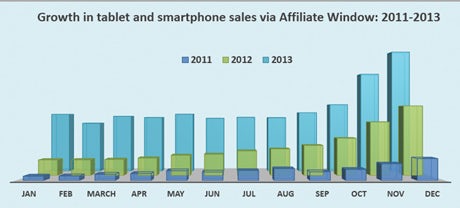Affiliate Window: The unsung hero of marketing has much to sing about
Advertisement feature
Affiliate Window’s Kevin Edwards discusses why it is the UK’s performance marketers who are setting the channel’s global gold standard in a multi-channel world.

![]()
It’s easy to regurgitate headline statistics from the now annual PwC Online Performance Marketing Study to state the case for brands investing in the performance channel. According to the study, it’s a £14bn industry generating 210 million sales and 3 billion clicks, offering advertisers a return on investment (ROI) of £14 for every pound spent.
But what is often missed when performance marketers roll out the impressive figures is the nuance and detail that makes the industry compelling and unique.
The complexity of the channel has always been its greatest strength as well as its biggest weakness. Too often brands are put off simply by the amount of time needed to make both sense and a success of it. In many ways the industry isn’t complicated at all but it has many shades and variations: it’s not a channel you can template.
There also persists a belief in certain quarters that performance marketing is second (or even third) tier in importance and something of an afterthought. This can often be politically motivated, with some affiliate suppliers choosing to focus their attention on ‘easier’ channels with higher margins (for them rather than their clients), but when we have direct access to an engaged advertiser we can often produce some of the most transparent and accountable marketing available to them.
When major brands invest – Affiliate Window works with over half of the top 100 retailers in the UK – performance marketing will frequently deliver a disproportionate amount of sales, often at odds with the cost of other less ROI-driven channels. For some of our top clients the percentage of online sales delivered by publishers is invariably in double figures. For a major department store it’s one in seven sales, while a huge telecoms company records one in four transactions via affiliate links.
Performance marketing isn’t for everyone. Big brands can struggle and SMEs can find themselves overlooked in a crowded marketplace of thousands of programmes. Often advertisers fail because they don’t have a clear idea of what they want the channel to deliver. The flexibility offered can often mean programmes lack focus.

Where we see true innovation is when performance marketing is seen as an intrinsic part of the brand’s overall marketing efforts. Some of the major successes of the past year have come as a result of an account handler working within the organisation either full or part-time, immersing themselves in their client’s company culture. Performance marketing is opportunistic: access to marketing plans both off and online invariably throws up prospects to enhance or expand planned activity.
In launching a major product for a big client last year, publishers were an intrinsic part of the picture, consulting on landing page navigation and optimisation. Retail vouchers were sourced to incentivise conversions. Bespoke commission rates and deals were trialled across a number of key partners with real time reports enhanced with customer quality metrics to ensure budget could be focused on those publishers delivering both quantity and quality.
These are serious marketing efforts that aren’t unique to a single engaged retailer. Innovation like this is happening across the board. Much of the success is unsung as the channel is perceived by more traditional marketers (within agencies as well as advertiser side) as being opaque and troublesome.

Perhaps it’s because much of the budget sits outside the agency remit that performance marketing fails to get attention from certain quarters. Certainly there seems to be a disconnect between the conversations we frequently have with senior acquisition marketers and those responsible for wider digital budgets.
Undoubtedly networks’ efforts have been aided significantly by publishers forging themselves into brands. With 4 million members, Quidco, the UK’s pre-eminent cashback site, has more traffic and drives more sales than 99 per cent of the retailers it features. It’s a retail destination in its own right and contrary to perception, acts as a point of entry in the retail purchase cycle as well as an obvious closer of the sale.
What is fascinating about these publisher ‘brands’ is how their multi-channel efforts are aping those of the retailers they’re promoting.
With major retailers focused on understanding their customers at every stage of the offline and online purchase journey across multiple devices, publishers have similarly created avenues to serve customers at every point. It’s now common for major branded publishers such as Quidco, vouchercodes.co.uk and uSwitch to offer a variety of ways of interacting with customers, be it via a mobile site, an app, in-store, email, push notification or their traditional desktop business. Typically these multi-channel customers spend more and purchase more frequently making them even more valuable.

Furthermore, publishers are recognising how they can commoditise their data to offer something personalised and targeted. Continued alignment with consumer routes to market should bind publishers more closely to brands as well as unlock additional ‘non-affiliate’ budgets.
As an acquisition channel, publishers have also suffered from being seen as ‘brass tacks’, ‘bread and butter marketing’ or a workhorse channel that is necessary but unloved. It’s true there is a ‘does what it says on the tin’ element but in these digitally disruptive and uncertain times, why is this a bad thing? Being able to see sales consistently stack up in a reporting interface should give any marketer solace.
Brands are also turning to UK performance marketers to capitalise on their overseas ambitions, reaching out to consumers hungry for UK brands. Given British performance marketers set the gold standard when it comes to acquisition (never assume the US performance space is similar to that of the UK), this is a fantastic place to build global retail empires.
In a sense, it shouldn’t be a concern that performance marketing in the UK doesn’t receive the recognition it rightfully deserves: we can quietly build impressive campaigns delivering huge value for our clients with publishers cementing themselves as true affinity partners.
But in an ever more crowded digital world that marketers are struggling to understand, we should be extolling the purity and compulsion of the channel’s steady and assured ability to consistently pull in sales across a range of devices, online and in-store, day in and day out.
Kevin Edwards
Strategy director
Affiliate Window
3rd Floor, 100 Leman Street
London
E1 8EU
T: 0844 557 9240
E: questions@affiliatewindow.com
W: www.affiliatewindow.com






